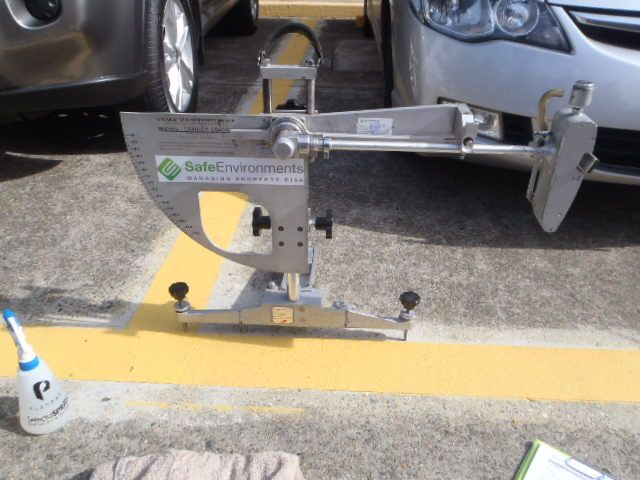Skid & Slip Resistance of Carpark Line Markings
Car parking areas are high traffic, high risk areas. The lines used to mark out the carpark areas are usually designed to stand out and give clear indications to traffic and the direction of travel. The line marking also needs to be slip resistant for both pedestrian and motor vehicle traffic, but how would the slip resistance of line marking be measured? And also how slip resistant should the line markings be?
Are carparking lines specifically made to be skid & slip resistant?
Line marking, whether on roads or in a car park, should in principle be applied with slip resistance in mind. One method of making the line marking slip resistant is by casting some form of grit over the top of the uncured polymer, another method is to incorporate the grit into the polymer before it is put on the surface. These methods are susceptible to wear and tear and if left unchecked all the grit can be worn away, leaving line marking with comparative less slip resistance.
How do you measure the skid & slip resistance of line markings?
Slip resistance of a car park is measured by the Wet Pendulum Slip Resistance Test using two different hardness rubbers, 4S (#96) being representative of a shoe sole, and TRL (#55) representative of a car tyre. This ensures that not only the possibility of a pedestrian slipping is estimated but also that of the car that needs to stop suddenly to avoid collision. The skid resistance testing of surfaces can be used through the pendulum device as well as other skid resistance measuring instruments.
What slip rating should the line markings achieve for pedestrian safety?
Standards Australia Hand Book 197 recommends multi-storey car parks to achieve a ramp rating of R10; our interpretation is that newly constructed car parks areas should achieve a slip rating of R10, W or P4 (to the latest 2013 standard) which is 45 BPN or above when using 4S rubber and above 40 when using TRL rubber. This slip rating is recommended due to the high likelihood of water getting onto the surface because of cars moving in and out during heavy rain and that any part of the carpark may be considered a pedestrian crossing. Other information in the public domain requires to be viewed in light of skid resistance assessment.
Because the car parks are high traffic areas the line marking can easily be worn down with time, this means that regular maintenance and checks through slip resistance testing by a NATA accredited company such as Slip Check, are essential to maintaining a slip resistant surface.
We recently performed a before and after treatment slip test on some car park line marking and found that the old worn down lines had dipped considerably below the recommended slip rating. Post-treatment slip testing found that the new carpark marking lines were well above the recommended level, meaning that even with some wear and tear, the new lines should last some time before requiring another treatment. Regular slip testing however is recommended to assess when rectification may be required.
More information on the slip and skid resistance of carpark line markings?
For more information on control measures to reduce the risk of slip and falls, including slip resistance testing of car parking areas and line marking, please contact the Slip Check team at Safe Environments in Sydney or Melbourne.
Author: Carl Strautins

Email: Carl@SafeEnvironments.com.au
Web: www.SafeEnvironments.com.au
As a principle at Safe Environments, Carl Strautins first started his career at CSIRO conducting research in slip resistance and developed the accelerated wear slip resistance test. He holds a degree in materials science, masters in occupational health and safety and a masters in science in occupational hygiene, Carl provides guidance to industry to minimise the risk of slip and fall incidents. He is engaged on a regular basis to provide expert opinion for disputes and legal proceedings.


